Vodafone HR Report: Individual, Team, and Organizational Growth
VerifiedAdded on 2020/06/06
|16
|4196
|153
Report
AI Summary
This comprehensive report delves into the critical aspects of human resources and organizational development, using Vodafone as a case study. It begins by outlining the essential professional knowledge, skills, and behaviors required of HR professionals, including their roles in recruitment, policy implementation, and maintaining workplace equality. The report then explores personal skills audits and the creation of professional development plans, providing a framework for individual growth and career progression. Furthermore, it examines the differences between organizational and individual learning, emphasizing the need for continuous learning and professional development within the company. The report also investigates the contribution of high-performance working to employee engagement and competitive advantage and different approaches to performance management. In conclusion, it highlights the significance of fostering collaborative working environments to enhance overall organizational success.
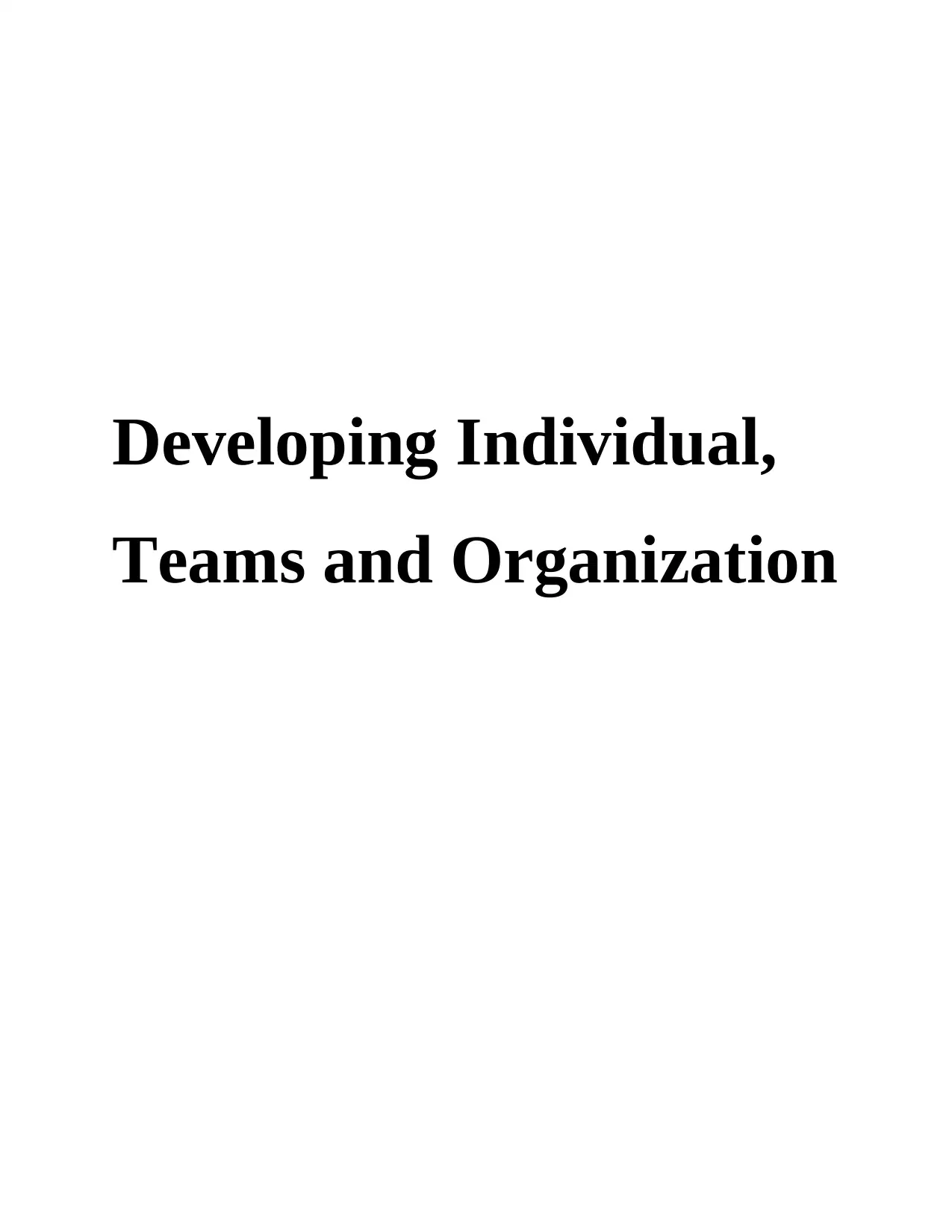
Developing Individual,
Teams and Organization
Teams and Organization
Secure Best Marks with AI Grader
Need help grading? Try our AI Grader for instant feedback on your assignments.
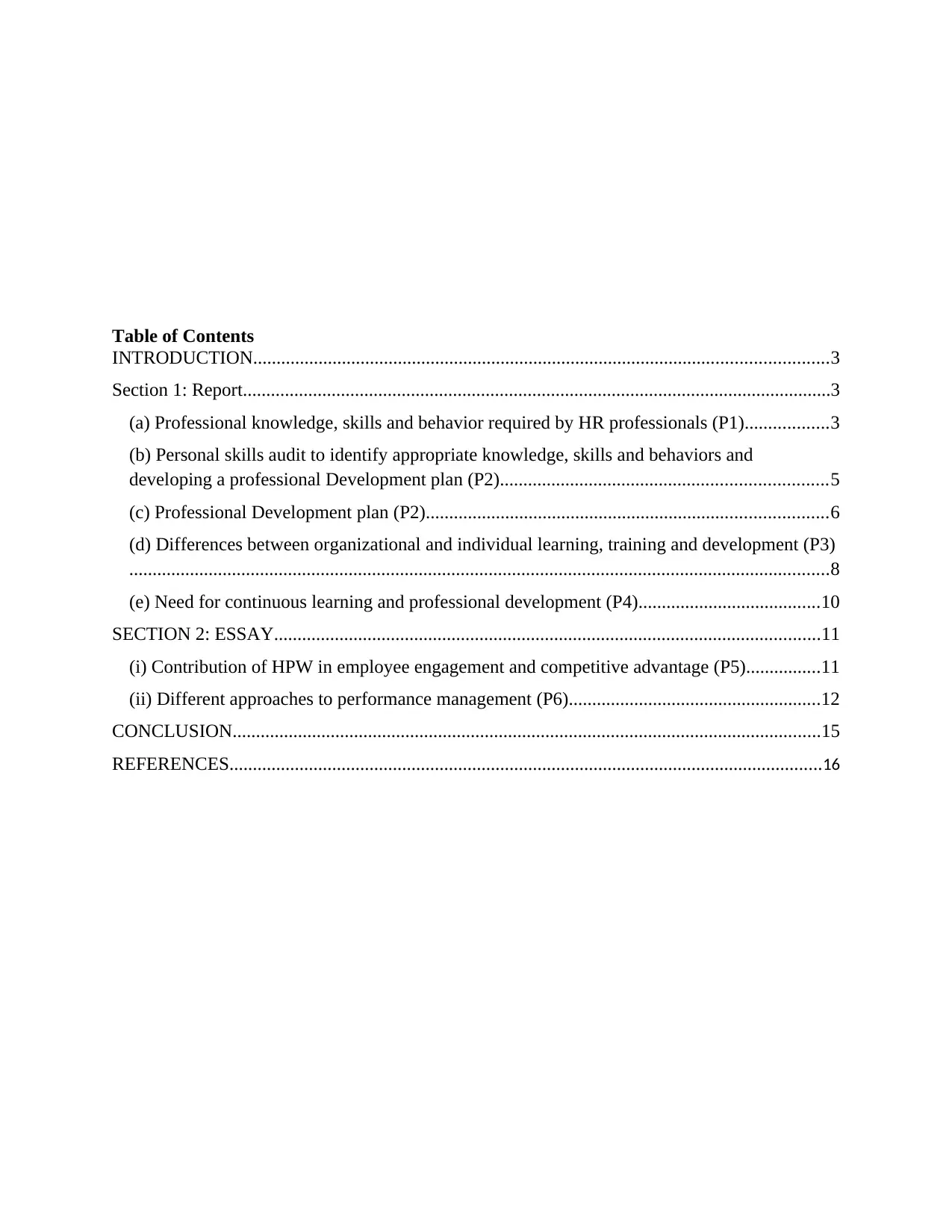
Table of Contents
INTRODUCTION...........................................................................................................................3
Section 1: Report..............................................................................................................................3
(a) Professional knowledge, skills and behavior required by HR professionals (P1)..................3
(b) Personal skills audit to identify appropriate knowledge, skills and behaviors and
developing a professional Development plan (P2)......................................................................5
(c) Professional Development plan (P2)......................................................................................6
(d) Differences between organizational and individual learning, training and development (P3)
......................................................................................................................................................8
(e) Need for continuous learning and professional development (P4).......................................10
SECTION 2: ESSAY.....................................................................................................................11
(i) Contribution of HPW in employee engagement and competitive advantage (P5)................11
(ii) Different approaches to performance management (P6)......................................................12
CONCLUSION..............................................................................................................................15
REFERENCES...............................................................................................................................16
INTRODUCTION...........................................................................................................................3
Section 1: Report..............................................................................................................................3
(a) Professional knowledge, skills and behavior required by HR professionals (P1)..................3
(b) Personal skills audit to identify appropriate knowledge, skills and behaviors and
developing a professional Development plan (P2)......................................................................5
(c) Professional Development plan (P2)......................................................................................6
(d) Differences between organizational and individual learning, training and development (P3)
......................................................................................................................................................8
(e) Need for continuous learning and professional development (P4).......................................10
SECTION 2: ESSAY.....................................................................................................................11
(i) Contribution of HPW in employee engagement and competitive advantage (P5)................11
(ii) Different approaches to performance management (P6)......................................................12
CONCLUSION..............................................................................................................................15
REFERENCES...............................................................................................................................16
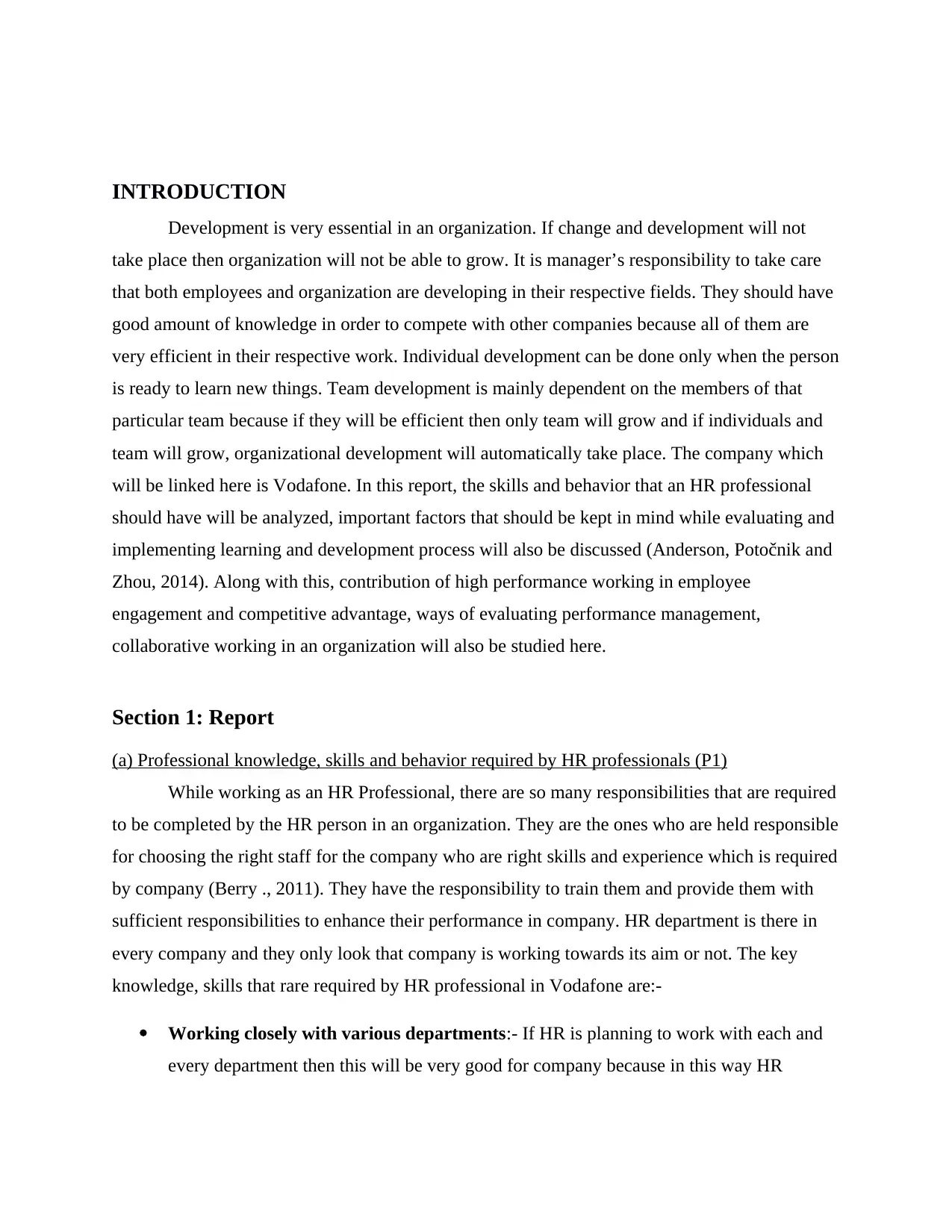
INTRODUCTION
Development is very essential in an organization. If change and development will not
take place then organization will not be able to grow. It is manager’s responsibility to take care
that both employees and organization are developing in their respective fields. They should have
good amount of knowledge in order to compete with other companies because all of them are
very efficient in their respective work. Individual development can be done only when the person
is ready to learn new things. Team development is mainly dependent on the members of that
particular team because if they will be efficient then only team will grow and if individuals and
team will grow, organizational development will automatically take place. The company which
will be linked here is Vodafone. In this report, the skills and behavior that an HR professional
should have will be analyzed, important factors that should be kept in mind while evaluating and
implementing learning and development process will also be discussed (Anderson, Potočnik and
Zhou, 2014). Along with this, contribution of high performance working in employee
engagement and competitive advantage, ways of evaluating performance management,
collaborative working in an organization will also be studied here.
Section 1: Report
(a) Professional knowledge, skills and behavior required by HR professionals (P1)
While working as an HR Professional, there are so many responsibilities that are required
to be completed by the HR person in an organization. They are the ones who are held responsible
for choosing the right staff for the company who are right skills and experience which is required
by company (Berry ., 2011). They have the responsibility to train them and provide them with
sufficient responsibilities to enhance their performance in company. HR department is there in
every company and they only look that company is working towards its aim or not. The key
knowledge, skills that rare required by HR professional in Vodafone are:-
Working closely with various departments:- If HR is planning to work with each and
every department then this will be very good for company because in this way HR
Development is very essential in an organization. If change and development will not
take place then organization will not be able to grow. It is manager’s responsibility to take care
that both employees and organization are developing in their respective fields. They should have
good amount of knowledge in order to compete with other companies because all of them are
very efficient in their respective work. Individual development can be done only when the person
is ready to learn new things. Team development is mainly dependent on the members of that
particular team because if they will be efficient then only team will grow and if individuals and
team will grow, organizational development will automatically take place. The company which
will be linked here is Vodafone. In this report, the skills and behavior that an HR professional
should have will be analyzed, important factors that should be kept in mind while evaluating and
implementing learning and development process will also be discussed (Anderson, Potočnik and
Zhou, 2014). Along with this, contribution of high performance working in employee
engagement and competitive advantage, ways of evaluating performance management,
collaborative working in an organization will also be studied here.
Section 1: Report
(a) Professional knowledge, skills and behavior required by HR professionals (P1)
While working as an HR Professional, there are so many responsibilities that are required
to be completed by the HR person in an organization. They are the ones who are held responsible
for choosing the right staff for the company who are right skills and experience which is required
by company (Berry ., 2011). They have the responsibility to train them and provide them with
sufficient responsibilities to enhance their performance in company. HR department is there in
every company and they only look that company is working towards its aim or not. The key
knowledge, skills that rare required by HR professional in Vodafone are:-
Working closely with various departments:- If HR is planning to work with each and
every department then this will be very good for company because in this way HR
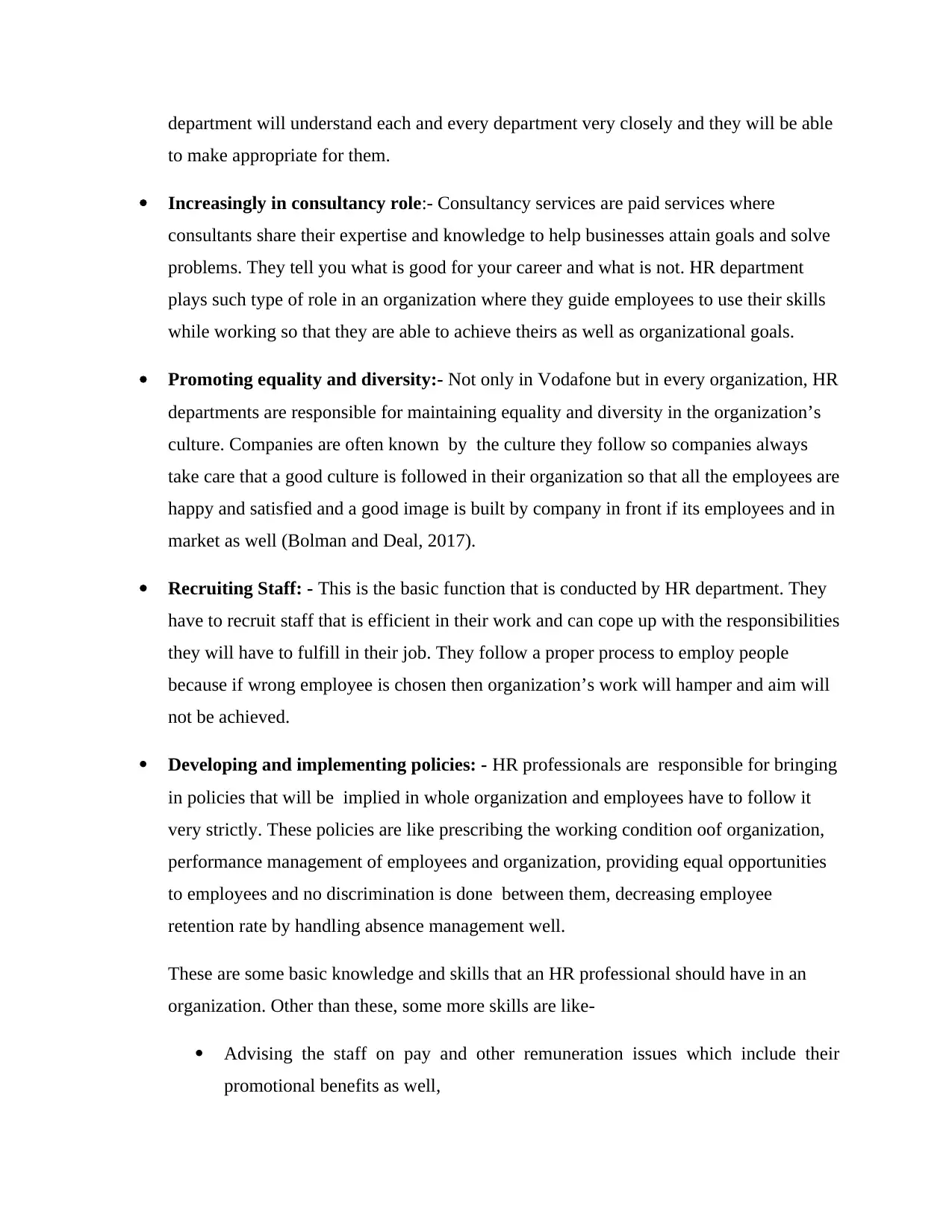
department will understand each and every department very closely and they will be able
to make appropriate for them.
Increasingly in consultancy role:- Consultancy services are paid services where
consultants share their expertise and knowledge to help businesses attain goals and solve
problems. They tell you what is good for your career and what is not. HR department
plays such type of role in an organization where they guide employees to use their skills
while working so that they are able to achieve theirs as well as organizational goals.
Promoting equality and diversity:- Not only in Vodafone but in every organization, HR
departments are responsible for maintaining equality and diversity in the organization’s
culture. Companies are often known by the culture they follow so companies always
take care that a good culture is followed in their organization so that all the employees are
happy and satisfied and a good image is built by company in front if its employees and in
market as well (Bolman and Deal, 2017).
Recruiting Staff: - This is the basic function that is conducted by HR department. They
have to recruit staff that is efficient in their work and can cope up with the responsibilities
they will have to fulfill in their job. They follow a proper process to employ people
because if wrong employee is chosen then organization’s work will hamper and aim will
not be achieved.
Developing and implementing policies: - HR professionals are responsible for bringing
in policies that will be implied in whole organization and employees have to follow it
very strictly. These policies are like prescribing the working condition oof organization,
performance management of employees and organization, providing equal opportunities
to employees and no discrimination is done between them, decreasing employee
retention rate by handling absence management well.
These are some basic knowledge and skills that an HR professional should have in an
organization. Other than these, some more skills are like-
Advising the staff on pay and other remuneration issues which include their
promotional benefits as well,
to make appropriate for them.
Increasingly in consultancy role:- Consultancy services are paid services where
consultants share their expertise and knowledge to help businesses attain goals and solve
problems. They tell you what is good for your career and what is not. HR department
plays such type of role in an organization where they guide employees to use their skills
while working so that they are able to achieve theirs as well as organizational goals.
Promoting equality and diversity:- Not only in Vodafone but in every organization, HR
departments are responsible for maintaining equality and diversity in the organization’s
culture. Companies are often known by the culture they follow so companies always
take care that a good culture is followed in their organization so that all the employees are
happy and satisfied and a good image is built by company in front if its employees and in
market as well (Bolman and Deal, 2017).
Recruiting Staff: - This is the basic function that is conducted by HR department. They
have to recruit staff that is efficient in their work and can cope up with the responsibilities
they will have to fulfill in their job. They follow a proper process to employ people
because if wrong employee is chosen then organization’s work will hamper and aim will
not be achieved.
Developing and implementing policies: - HR professionals are responsible for bringing
in policies that will be implied in whole organization and employees have to follow it
very strictly. These policies are like prescribing the working condition oof organization,
performance management of employees and organization, providing equal opportunities
to employees and no discrimination is done between them, decreasing employee
retention rate by handling absence management well.
These are some basic knowledge and skills that an HR professional should have in an
organization. Other than these, some more skills are like-
Advising the staff on pay and other remuneration issues which include their
promotional benefits as well,
Secure Best Marks with AI Grader
Need help grading? Try our AI Grader for instant feedback on your assignments.
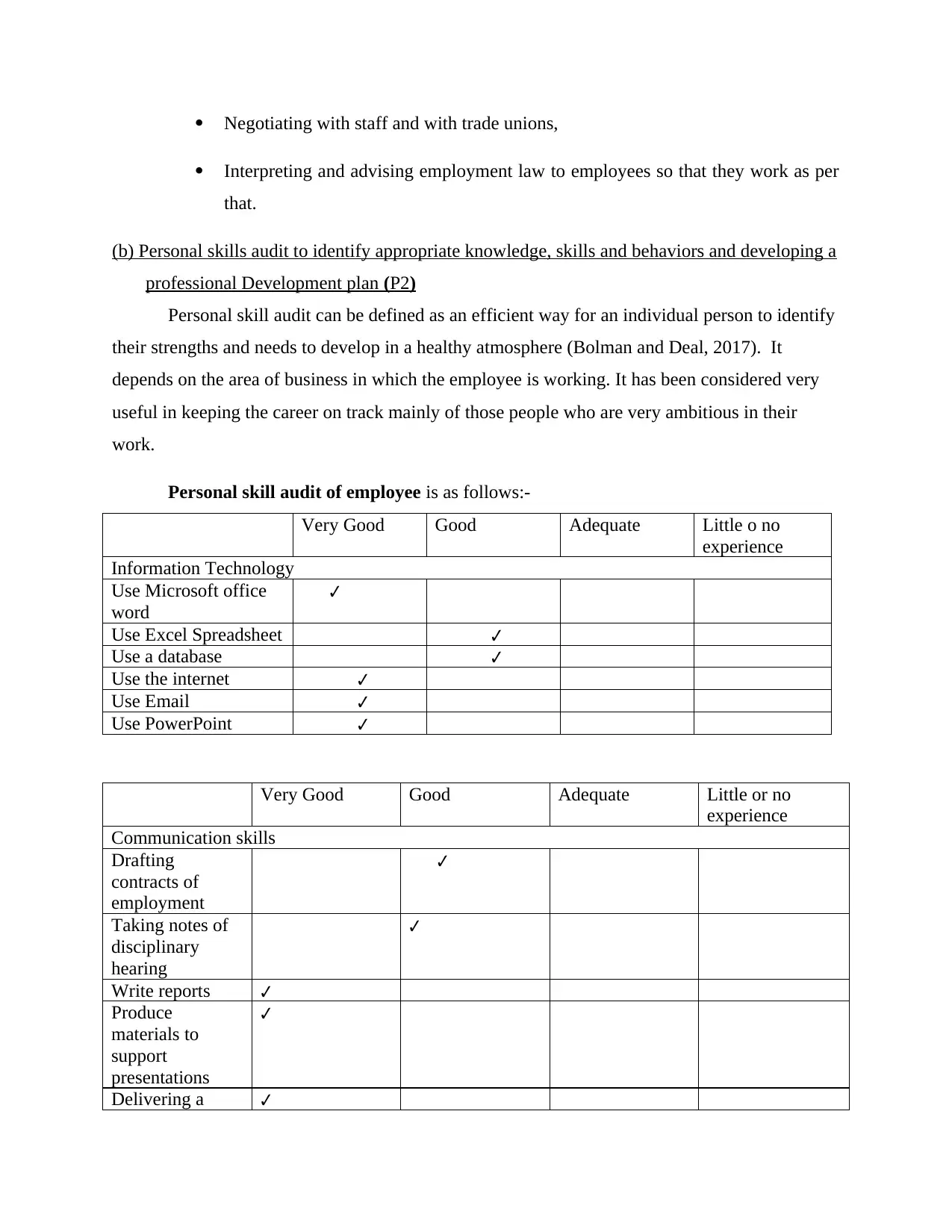
Negotiating with staff and with trade unions,
Interpreting and advising employment law to employees so that they work as per
that.
(b) Personal skills audit to identify appropriate knowledge, skills and behaviors and developing a
professional Development plan (P2)
Personal skill audit can be defined as an efficient way for an individual person to identify
their strengths and needs to develop in a healthy atmosphere (Bolman and Deal, 2017). It
depends on the area of business in which the employee is working. It has been considered very
useful in keeping the career on track mainly of those people who are very ambitious in their
work.
Personal skill audit of employee is as follows:-
Very Good Good Adequate Little o no
experience
Information Technology
Use Microsoft office
word
✔
Use Excel Spreadsheet ✔
Use a database ✔
Use the internet ✔
Use Email ✔
Use PowerPoint ✔
Very Good Good Adequate Little or no
experience
Communication skills
Drafting
contracts of
employment
✔
Taking notes of
disciplinary
hearing
✔
Write reports ✔
Produce
materials to
support
presentations
✔
Delivering a ✔
Interpreting and advising employment law to employees so that they work as per
that.
(b) Personal skills audit to identify appropriate knowledge, skills and behaviors and developing a
professional Development plan (P2)
Personal skill audit can be defined as an efficient way for an individual person to identify
their strengths and needs to develop in a healthy atmosphere (Bolman and Deal, 2017). It
depends on the area of business in which the employee is working. It has been considered very
useful in keeping the career on track mainly of those people who are very ambitious in their
work.
Personal skill audit of employee is as follows:-
Very Good Good Adequate Little o no
experience
Information Technology
Use Microsoft office
word
✔
Use Excel Spreadsheet ✔
Use a database ✔
Use the internet ✔
Use Email ✔
Use PowerPoint ✔
Very Good Good Adequate Little or no
experience
Communication skills
Drafting
contracts of
employment
✔
Taking notes of
disciplinary
hearing
✔
Write reports ✔
Produce
materials to
support
presentations
✔
Delivering a ✔
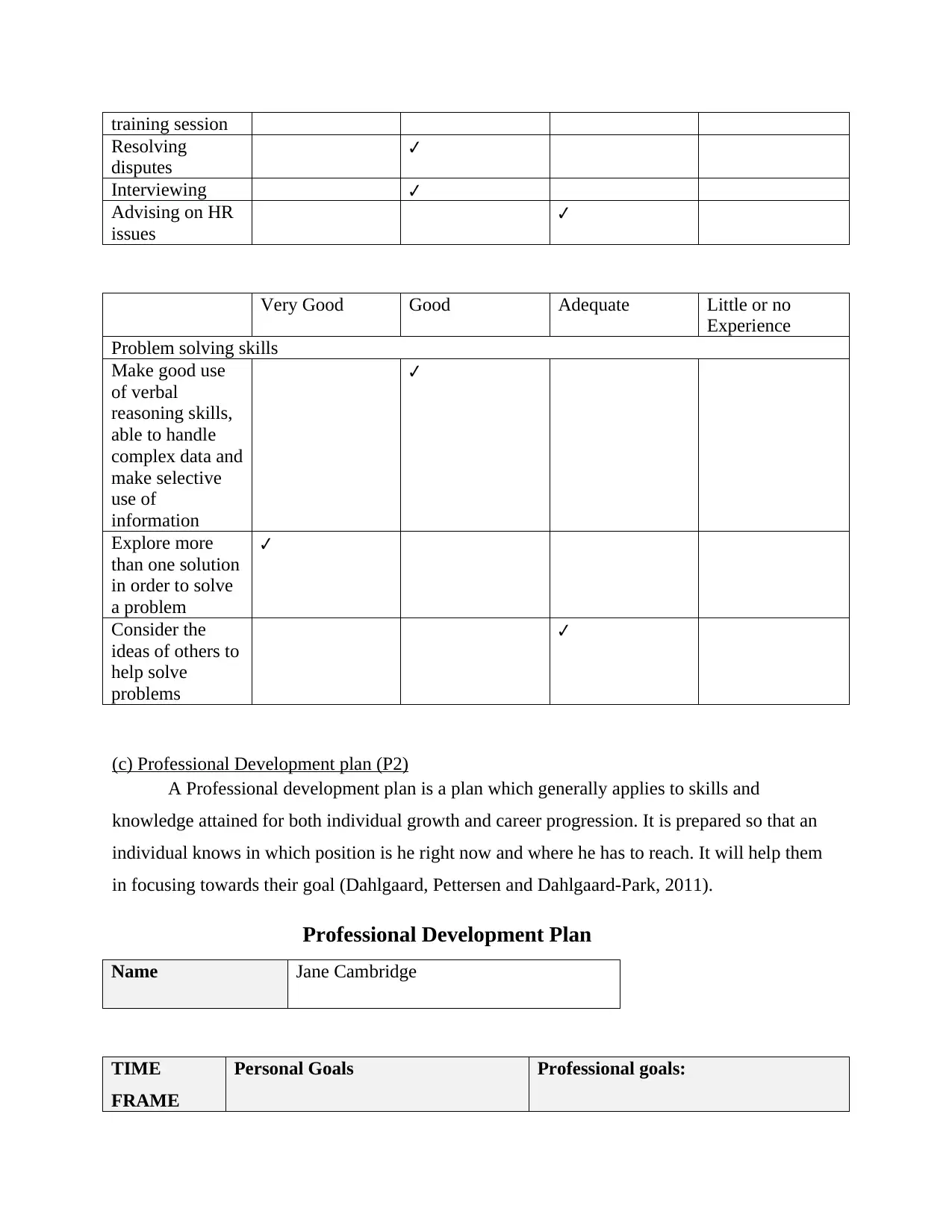
training session
Resolving
disputes
✔
Interviewing ✔
Advising on HR
issues
✔
Very Good Good Adequate Little or no
Experience
Problem solving skills
Make good use
of verbal
reasoning skills,
able to handle
complex data and
make selective
use of
information
✔
Explore more
than one solution
in order to solve
a problem
✔
Consider the
ideas of others to
help solve
problems
✔
(c) Professional Development plan (P2)
A Professional development plan is a plan which generally applies to skills and
knowledge attained for both individual growth and career progression. It is prepared so that an
individual knows in which position is he right now and where he has to reach. It will help them
in focusing towards their goal (Dahlgaard, Pettersen and Dahlgaard-Park, 2011).
Professional Development Plan
Name Jane Cambridge
TIME
FRAME
Personal Goals Professional goals:
Resolving
disputes
✔
Interviewing ✔
Advising on HR
issues
✔
Very Good Good Adequate Little or no
Experience
Problem solving skills
Make good use
of verbal
reasoning skills,
able to handle
complex data and
make selective
use of
information
✔
Explore more
than one solution
in order to solve
a problem
✔
Consider the
ideas of others to
help solve
problems
✔
(c) Professional Development plan (P2)
A Professional development plan is a plan which generally applies to skills and
knowledge attained for both individual growth and career progression. It is prepared so that an
individual knows in which position is he right now and where he has to reach. It will help them
in focusing towards their goal (Dahlgaard, Pettersen and Dahlgaard-Park, 2011).
Professional Development Plan
Name Jane Cambridge
TIME
FRAME
Personal Goals Professional goals:
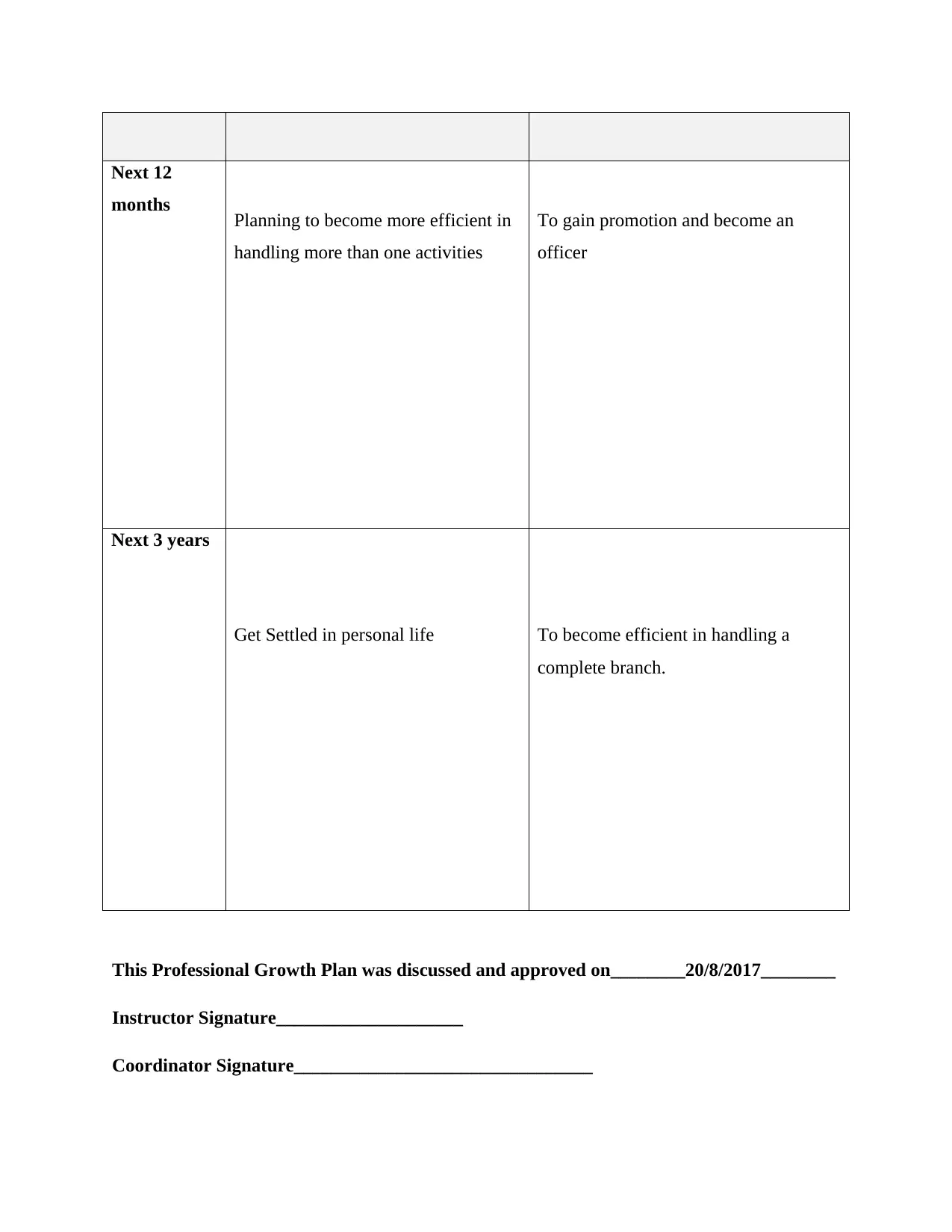
Next 12
months Planning to become more efficient in
handling more than one activities
To gain promotion and become an
officer
Next 3 years
Get Settled in personal life To become efficient in handling a
complete branch.
This Professional Growth Plan was discussed and approved on________20/8/2017________
Instructor Signature____________________
Coordinator Signature________________________________
months Planning to become more efficient in
handling more than one activities
To gain promotion and become an
officer
Next 3 years
Get Settled in personal life To become efficient in handling a
complete branch.
This Professional Growth Plan was discussed and approved on________20/8/2017________
Instructor Signature____________________
Coordinator Signature________________________________
Paraphrase This Document
Need a fresh take? Get an instant paraphrase of this document with our AI Paraphraser
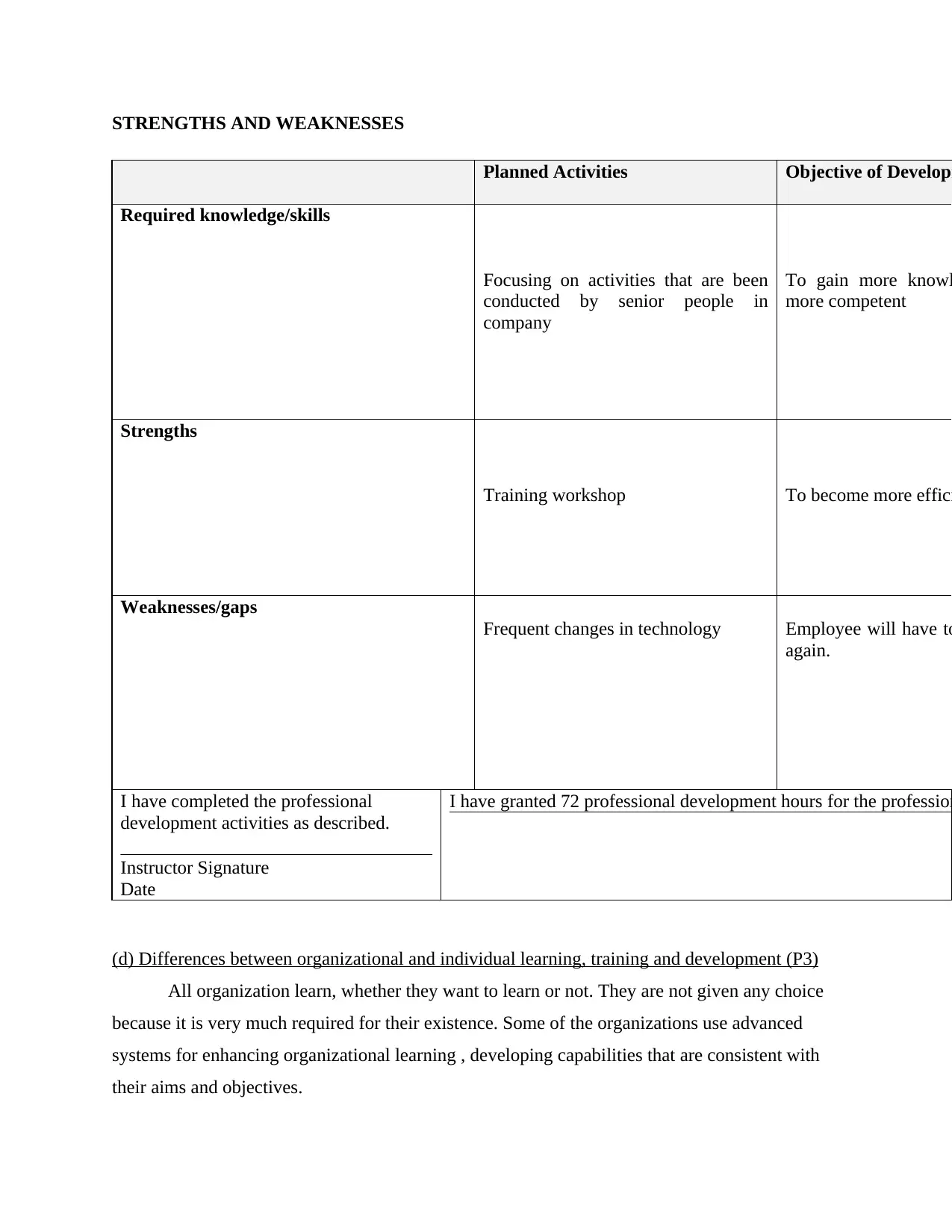
STRENGTHS AND WEAKNESSES
Planned Activities Objective of Developm
Required knowledge/skills
Focusing on activities that are been
conducted by senior people in
company
To gain more knowl
more competent
Strengths
Training workshop To become more effici
Weaknesses/gaps
Frequent changes in technology Employee will have to
again.
I have completed the professional
development activities as described.
Instructor Signature
Date
I have granted 72 professional development hours for the profession
(d) Differences between organizational and individual learning, training and development (P3)
All organization learn, whether they want to learn or not. They are not given any choice
because it is very much required for their existence. Some of the organizations use advanced
systems for enhancing organizational learning , developing capabilities that are consistent with
their aims and objectives.
Planned Activities Objective of Developm
Required knowledge/skills
Focusing on activities that are been
conducted by senior people in
company
To gain more knowl
more competent
Strengths
Training workshop To become more effici
Weaknesses/gaps
Frequent changes in technology Employee will have to
again.
I have completed the professional
development activities as described.
Instructor Signature
Date
I have granted 72 professional development hours for the profession
(d) Differences between organizational and individual learning, training and development (P3)
All organization learn, whether they want to learn or not. They are not given any choice
because it is very much required for their existence. Some of the organizations use advanced
systems for enhancing organizational learning , developing capabilities that are consistent with
their aims and objectives.
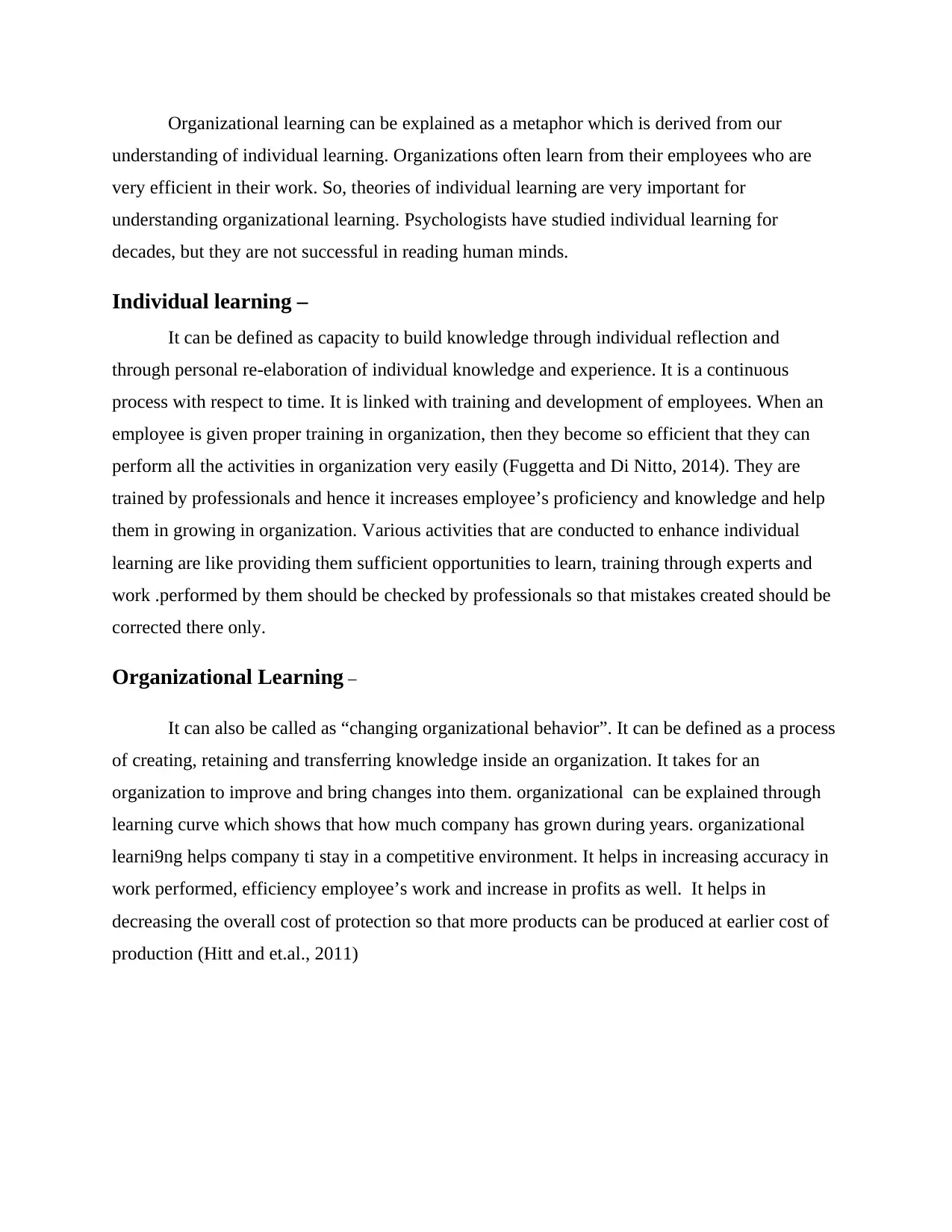
Organizational learning can be explained as a metaphor which is derived from our
understanding of individual learning. Organizations often learn from their employees who are
very efficient in their work. So, theories of individual learning are very important for
understanding organizational learning. Psychologists have studied individual learning for
decades, but they are not successful in reading human minds.
Individual learning –
It can be defined as capacity to build knowledge through individual reflection and
through personal re-elaboration of individual knowledge and experience. It is a continuous
process with respect to time. It is linked with training and development of employees. When an
employee is given proper training in organization, then they become so efficient that they can
perform all the activities in organization very easily (Fuggetta and Di Nitto, 2014). They are
trained by professionals and hence it increases employee’s proficiency and knowledge and help
them in growing in organization. Various activities that are conducted to enhance individual
learning are like providing them sufficient opportunities to learn, training through experts and
work .performed by them should be checked by professionals so that mistakes created should be
corrected there only.
Organizational Learning –
It can also be called as “changing organizational behavior”. It can be defined as a process
of creating, retaining and transferring knowledge inside an organization. It takes for an
organization to improve and bring changes into them. organizational can be explained through
learning curve which shows that how much company has grown during years. organizational
learni9ng helps company ti stay in a competitive environment. It helps in increasing accuracy in
work performed, efficiency employee’s work and increase in profits as well. It helps in
decreasing the overall cost of protection so that more products can be produced at earlier cost of
production (Hitt and et.al., 2011)
understanding of individual learning. Organizations often learn from their employees who are
very efficient in their work. So, theories of individual learning are very important for
understanding organizational learning. Psychologists have studied individual learning for
decades, but they are not successful in reading human minds.
Individual learning –
It can be defined as capacity to build knowledge through individual reflection and
through personal re-elaboration of individual knowledge and experience. It is a continuous
process with respect to time. It is linked with training and development of employees. When an
employee is given proper training in organization, then they become so efficient that they can
perform all the activities in organization very easily (Fuggetta and Di Nitto, 2014). They are
trained by professionals and hence it increases employee’s proficiency and knowledge and help
them in growing in organization. Various activities that are conducted to enhance individual
learning are like providing them sufficient opportunities to learn, training through experts and
work .performed by them should be checked by professionals so that mistakes created should be
corrected there only.
Organizational Learning –
It can also be called as “changing organizational behavior”. It can be defined as a process
of creating, retaining and transferring knowledge inside an organization. It takes for an
organization to improve and bring changes into them. organizational can be explained through
learning curve which shows that how much company has grown during years. organizational
learni9ng helps company ti stay in a competitive environment. It helps in increasing accuracy in
work performed, efficiency employee’s work and increase in profits as well. It helps in
decreasing the overall cost of protection so that more products can be produced at earlier cost of
production (Hitt and et.al., 2011)
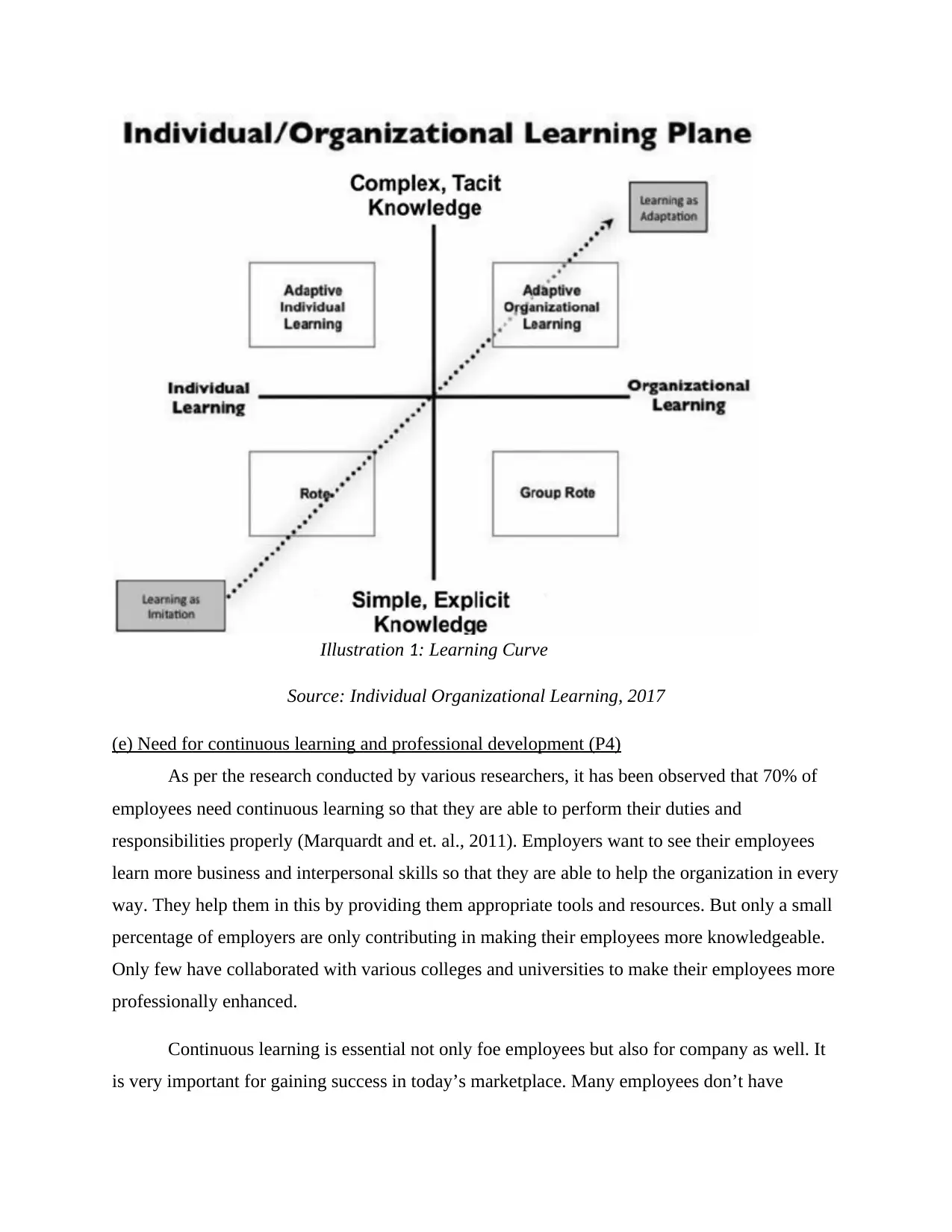
Illustration 1: Learning Curve
Source: Individual Organizational Learning, 2017
(e) Need for continuous learning and professional development (P4)
As per the research conducted by various researchers, it has been observed that 70% of
employees need continuous learning so that they are able to perform their duties and
responsibilities properly (Marquardt and et. al., 2011). Employers want to see their employees
learn more business and interpersonal skills so that they are able to help the organization in every
way. They help them in this by providing them appropriate tools and resources. But only a small
percentage of employers are only contributing in making their employees more knowledgeable.
Only few have collaborated with various colleges and universities to make their employees more
professionally enhanced.
Continuous learning is essential not only foe employees but also for company as well. It
is very important for gaining success in today’s marketplace. Many employees don’t have
Source: Individual Organizational Learning, 2017
(e) Need for continuous learning and professional development (P4)
As per the research conducted by various researchers, it has been observed that 70% of
employees need continuous learning so that they are able to perform their duties and
responsibilities properly (Marquardt and et. al., 2011). Employers want to see their employees
learn more business and interpersonal skills so that they are able to help the organization in every
way. They help them in this by providing them appropriate tools and resources. But only a small
percentage of employers are only contributing in making their employees more knowledgeable.
Only few have collaborated with various colleges and universities to make their employees more
professionally enhanced.
Continuous learning is essential not only foe employees but also for company as well. It
is very important for gaining success in today’s marketplace. Many employees don’t have
Secure Best Marks with AI Grader
Need help grading? Try our AI Grader for instant feedback on your assignments.
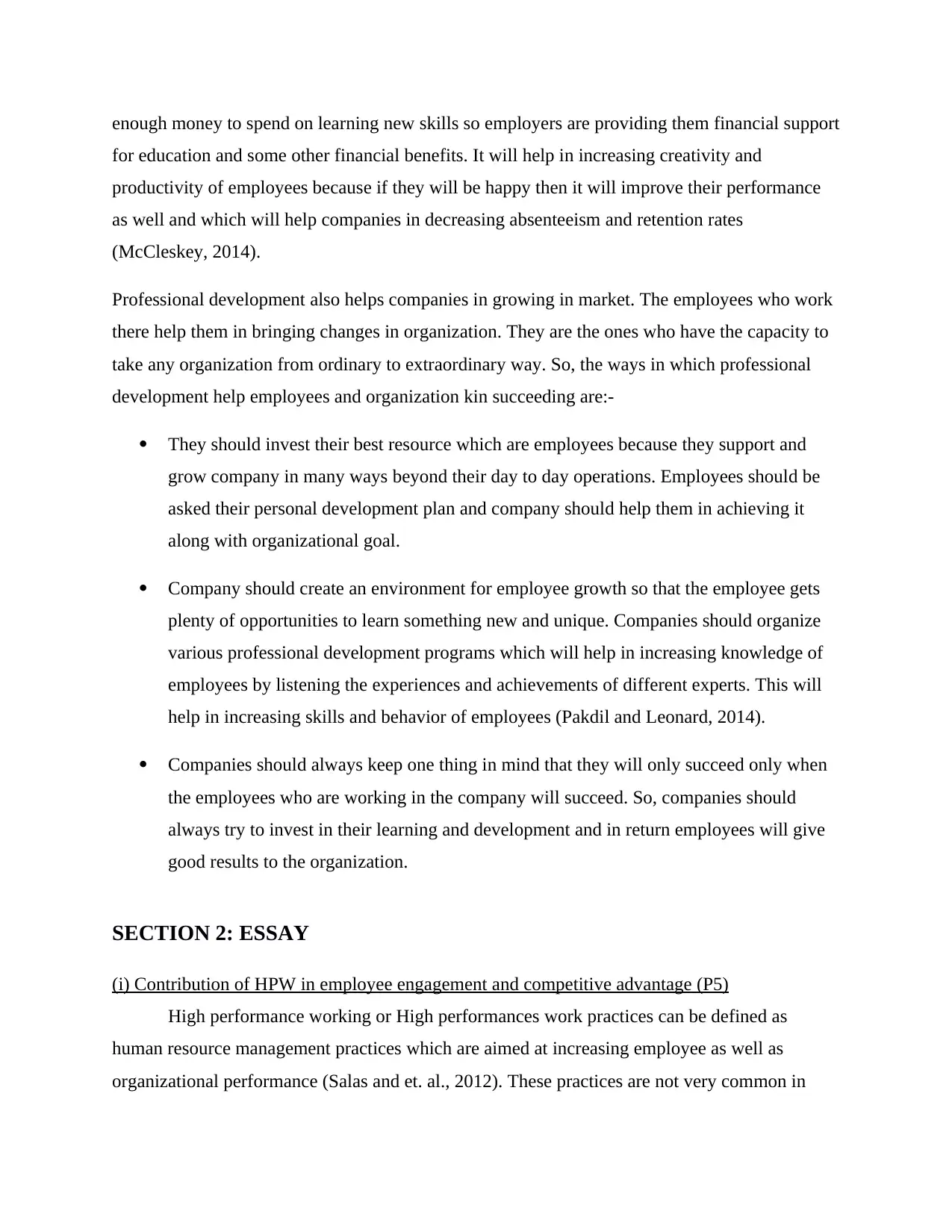
enough money to spend on learning new skills so employers are providing them financial support
for education and some other financial benefits. It will help in increasing creativity and
productivity of employees because if they will be happy then it will improve their performance
as well and which will help companies in decreasing absenteeism and retention rates
(McCleskey, 2014).
Professional development also helps companies in growing in market. The employees who work
there help them in bringing changes in organization. They are the ones who have the capacity to
take any organization from ordinary to extraordinary way. So, the ways in which professional
development help employees and organization kin succeeding are:-
They should invest their best resource which are employees because they support and
grow company in many ways beyond their day to day operations. Employees should be
asked their personal development plan and company should help them in achieving it
along with organizational goal.
Company should create an environment for employee growth so that the employee gets
plenty of opportunities to learn something new and unique. Companies should organize
various professional development programs which will help in increasing knowledge of
employees by listening the experiences and achievements of different experts. This will
help in increasing skills and behavior of employees (Pakdil and Leonard, 2014).
Companies should always keep one thing in mind that they will only succeed only when
the employees who are working in the company will succeed. So, companies should
always try to invest in their learning and development and in return employees will give
good results to the organization.
SECTION 2: ESSAY
(i) Contribution of HPW in employee engagement and competitive advantage (P5)
High performance working or High performances work practices can be defined as
human resource management practices which are aimed at increasing employee as well as
organizational performance (Salas and et. al., 2012). These practices are not very common in
for education and some other financial benefits. It will help in increasing creativity and
productivity of employees because if they will be happy then it will improve their performance
as well and which will help companies in decreasing absenteeism and retention rates
(McCleskey, 2014).
Professional development also helps companies in growing in market. The employees who work
there help them in bringing changes in organization. They are the ones who have the capacity to
take any organization from ordinary to extraordinary way. So, the ways in which professional
development help employees and organization kin succeeding are:-
They should invest their best resource which are employees because they support and
grow company in many ways beyond their day to day operations. Employees should be
asked their personal development plan and company should help them in achieving it
along with organizational goal.
Company should create an environment for employee growth so that the employee gets
plenty of opportunities to learn something new and unique. Companies should organize
various professional development programs which will help in increasing knowledge of
employees by listening the experiences and achievements of different experts. This will
help in increasing skills and behavior of employees (Pakdil and Leonard, 2014).
Companies should always keep one thing in mind that they will only succeed only when
the employees who are working in the company will succeed. So, companies should
always try to invest in their learning and development and in return employees will give
good results to the organization.
SECTION 2: ESSAY
(i) Contribution of HPW in employee engagement and competitive advantage (P5)
High performance working or High performances work practices can be defined as
human resource management practices which are aimed at increasing employee as well as
organizational performance (Salas and et. al., 2012). These practices are not very common in
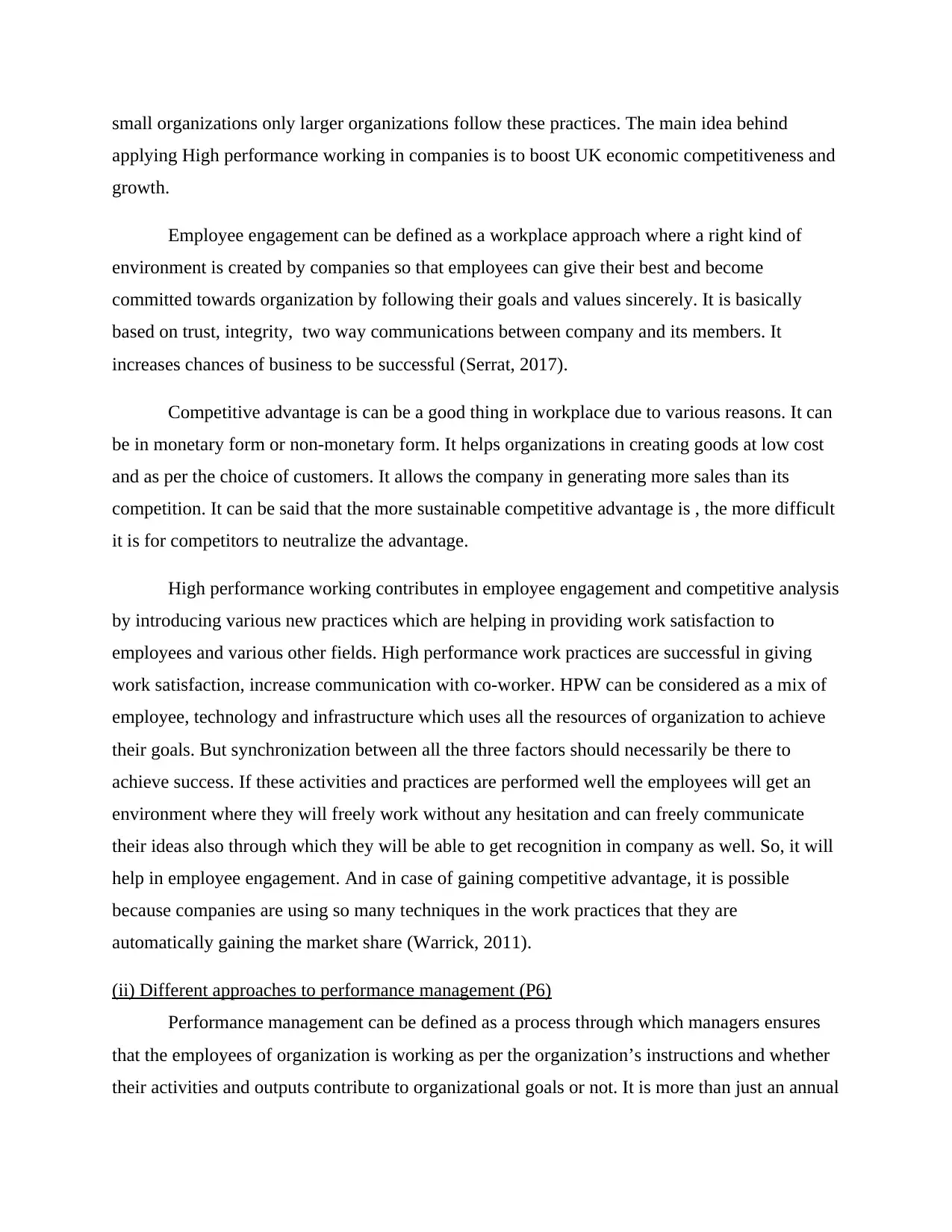
small organizations only larger organizations follow these practices. The main idea behind
applying High performance working in companies is to boost UK economic competitiveness and
growth.
Employee engagement can be defined as a workplace approach where a right kind of
environment is created by companies so that employees can give their best and become
committed towards organization by following their goals and values sincerely. It is basically
based on trust, integrity, two way communications between company and its members. It
increases chances of business to be successful (Serrat, 2017).
Competitive advantage is can be a good thing in workplace due to various reasons. It can
be in monetary form or non-monetary form. It helps organizations in creating goods at low cost
and as per the choice of customers. It allows the company in generating more sales than its
competition. It can be said that the more sustainable competitive advantage is , the more difficult
it is for competitors to neutralize the advantage.
High performance working contributes in employee engagement and competitive analysis
by introducing various new practices which are helping in providing work satisfaction to
employees and various other fields. High performance work practices are successful in giving
work satisfaction, increase communication with co-worker. HPW can be considered as a mix of
employee, technology and infrastructure which uses all the resources of organization to achieve
their goals. But synchronization between all the three factors should necessarily be there to
achieve success. If these activities and practices are performed well the employees will get an
environment where they will freely work without any hesitation and can freely communicate
their ideas also through which they will be able to get recognition in company as well. So, it will
help in employee engagement. And in case of gaining competitive advantage, it is possible
because companies are using so many techniques in the work practices that they are
automatically gaining the market share (Warrick, 2011).
(ii) Different approaches to performance management (P6)
Performance management can be defined as a process through which managers ensures
that the employees of organization is working as per the organization’s instructions and whether
their activities and outputs contribute to organizational goals or not. It is more than just an annual
applying High performance working in companies is to boost UK economic competitiveness and
growth.
Employee engagement can be defined as a workplace approach where a right kind of
environment is created by companies so that employees can give their best and become
committed towards organization by following their goals and values sincerely. It is basically
based on trust, integrity, two way communications between company and its members. It
increases chances of business to be successful (Serrat, 2017).
Competitive advantage is can be a good thing in workplace due to various reasons. It can
be in monetary form or non-monetary form. It helps organizations in creating goods at low cost
and as per the choice of customers. It allows the company in generating more sales than its
competition. It can be said that the more sustainable competitive advantage is , the more difficult
it is for competitors to neutralize the advantage.
High performance working contributes in employee engagement and competitive analysis
by introducing various new practices which are helping in providing work satisfaction to
employees and various other fields. High performance work practices are successful in giving
work satisfaction, increase communication with co-worker. HPW can be considered as a mix of
employee, technology and infrastructure which uses all the resources of organization to achieve
their goals. But synchronization between all the three factors should necessarily be there to
achieve success. If these activities and practices are performed well the employees will get an
environment where they will freely work without any hesitation and can freely communicate
their ideas also through which they will be able to get recognition in company as well. So, it will
help in employee engagement. And in case of gaining competitive advantage, it is possible
because companies are using so many techniques in the work practices that they are
automatically gaining the market share (Warrick, 2011).
(ii) Different approaches to performance management (P6)
Performance management can be defined as a process through which managers ensures
that the employees of organization is working as per the organization’s instructions and whether
their activities and outputs contribute to organizational goals or not. It is more than just an annual
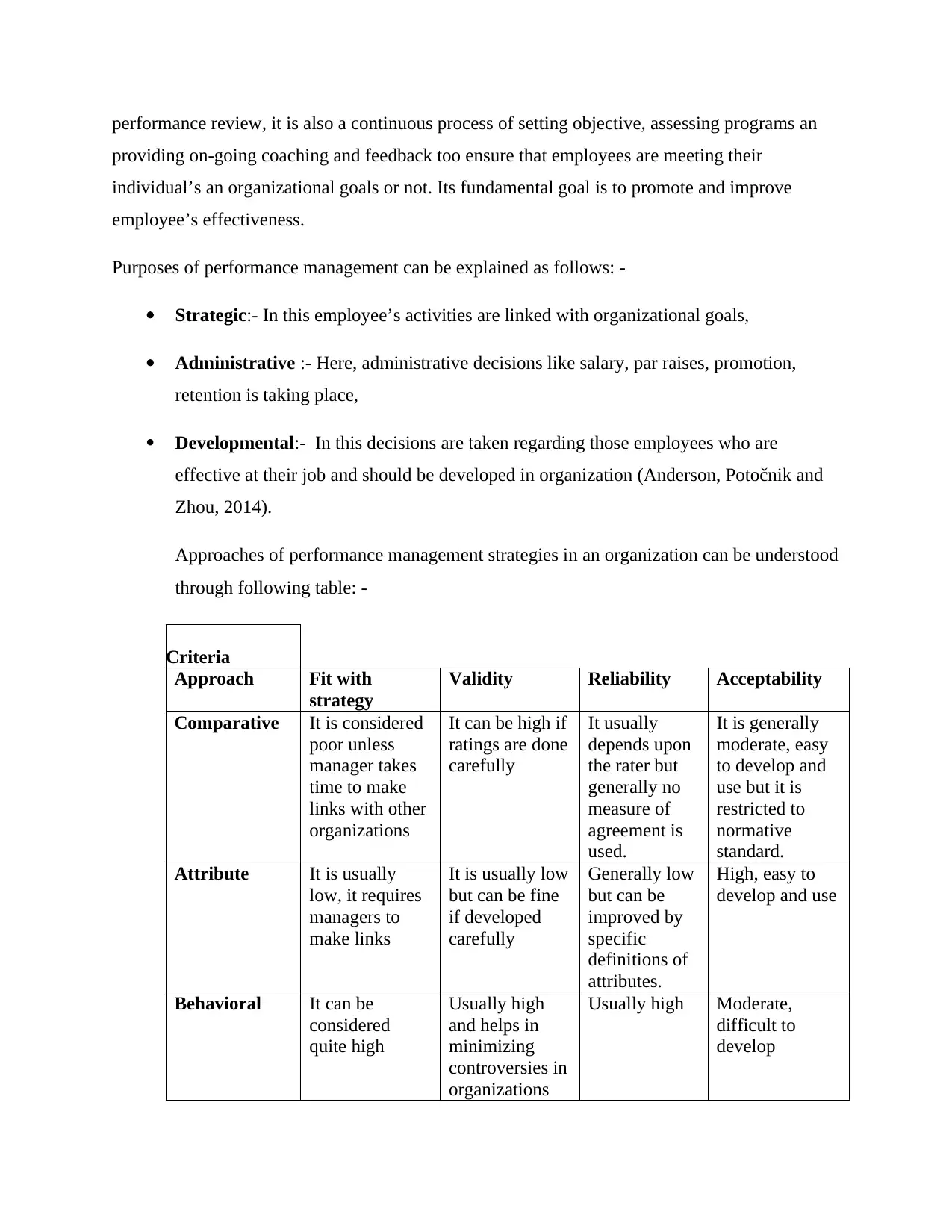
performance review, it is also a continuous process of setting objective, assessing programs an
providing on-going coaching and feedback too ensure that employees are meeting their
individual’s an organizational goals or not. Its fundamental goal is to promote and improve
employee’s effectiveness.
Purposes of performance management can be explained as follows: -
Strategic:- In this employee’s activities are linked with organizational goals,
Administrative :- Here, administrative decisions like salary, par raises, promotion,
retention is taking place,
Developmental:- In this decisions are taken regarding those employees who are
effective at their job and should be developed in organization (Anderson, Potočnik and
Zhou, 2014).
Approaches of performance management strategies in an organization can be understood
through following table: -
Criteria
Approach Fit with
strategy
Validity Reliability Acceptability
Comparative It is considered
poor unless
manager takes
time to make
links with other
organizations
It can be high if
ratings are done
carefully
It usually
depends upon
the rater but
generally no
measure of
agreement is
used.
It is generally
moderate, easy
to develop and
use but it is
restricted to
normative
standard.
Attribute It is usually
low, it requires
managers to
make links
It is usually low
but can be fine
if developed
carefully
Generally low
but can be
improved by
specific
definitions of
attributes.
High, easy to
develop and use
Behavioral It can be
considered
quite high
Usually high
and helps in
minimizing
controversies in
organizations
Usually high Moderate,
difficult to
develop
providing on-going coaching and feedback too ensure that employees are meeting their
individual’s an organizational goals or not. Its fundamental goal is to promote and improve
employee’s effectiveness.
Purposes of performance management can be explained as follows: -
Strategic:- In this employee’s activities are linked with organizational goals,
Administrative :- Here, administrative decisions like salary, par raises, promotion,
retention is taking place,
Developmental:- In this decisions are taken regarding those employees who are
effective at their job and should be developed in organization (Anderson, Potočnik and
Zhou, 2014).
Approaches of performance management strategies in an organization can be understood
through following table: -
Criteria
Approach Fit with
strategy
Validity Reliability Acceptability
Comparative It is considered
poor unless
manager takes
time to make
links with other
organizations
It can be high if
ratings are done
carefully
It usually
depends upon
the rater but
generally no
measure of
agreement is
used.
It is generally
moderate, easy
to develop and
use but it is
restricted to
normative
standard.
Attribute It is usually
low, it requires
managers to
make links
It is usually low
but can be fine
if developed
carefully
Generally low
but can be
improved by
specific
definitions of
attributes.
High, easy to
develop and use
Behavioral It can be
considered
quite high
Usually high
and helps in
minimizing
controversies in
organizations
Usually high Moderate,
difficult to
develop
Paraphrase This Document
Need a fresh take? Get an instant paraphrase of this document with our AI Paraphraser
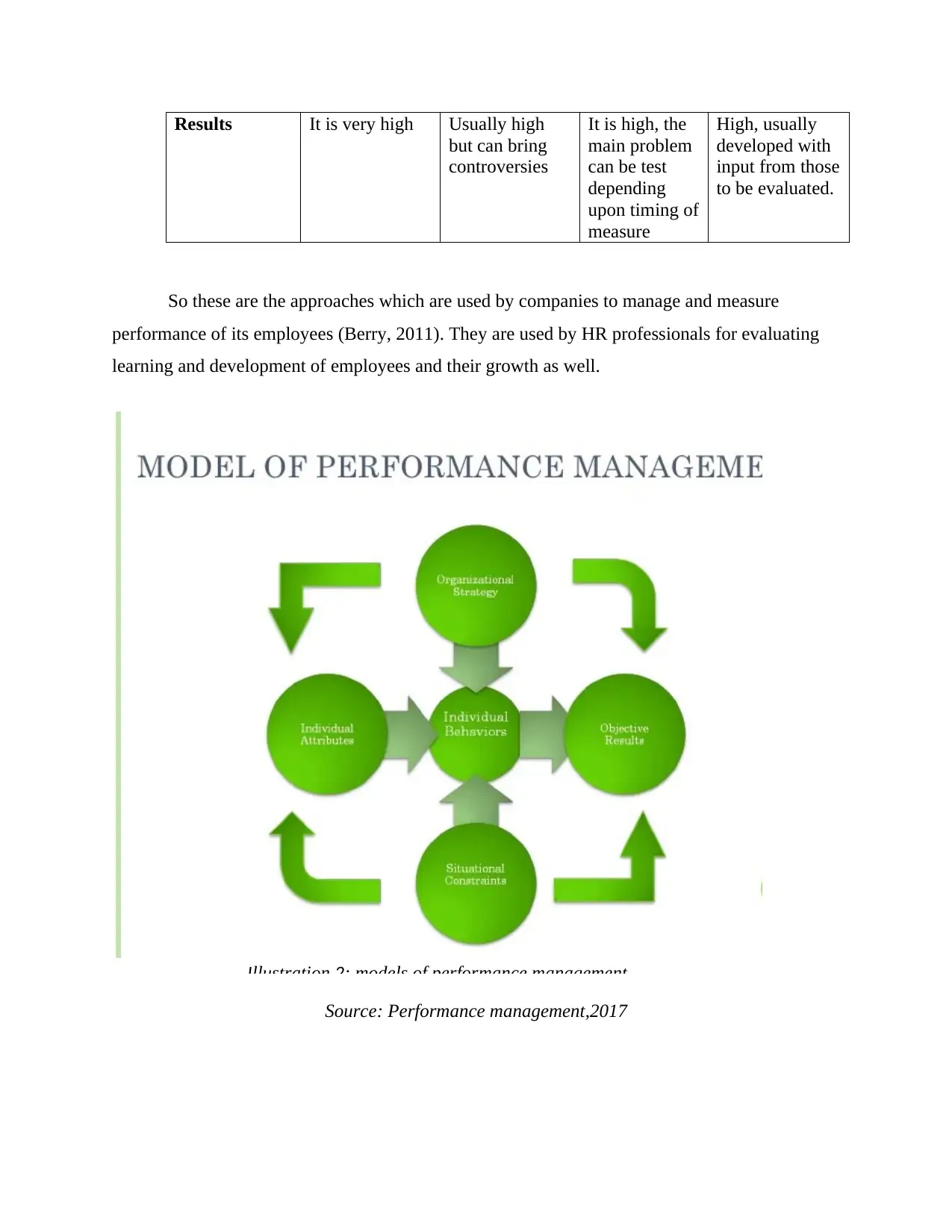
Results It is very high Usually high
but can bring
controversies
It is high, the
main problem
can be test
depending
upon timing of
measure
High, usually
developed with
input from those
to be evaluated.
So these are the approaches which are used by companies to manage and measure
performance of its employees (Berry, 2011). They are used by HR professionals for evaluating
learning and development of employees and their growth as well.
Illustration 2: models of performance management
Source: Performance management,2017
but can bring
controversies
It is high, the
main problem
can be test
depending
upon timing of
measure
High, usually
developed with
input from those
to be evaluated.
So these are the approaches which are used by companies to manage and measure
performance of its employees (Berry, 2011). They are used by HR professionals for evaluating
learning and development of employees and their growth as well.
Illustration 2: models of performance management
Source: Performance management,2017
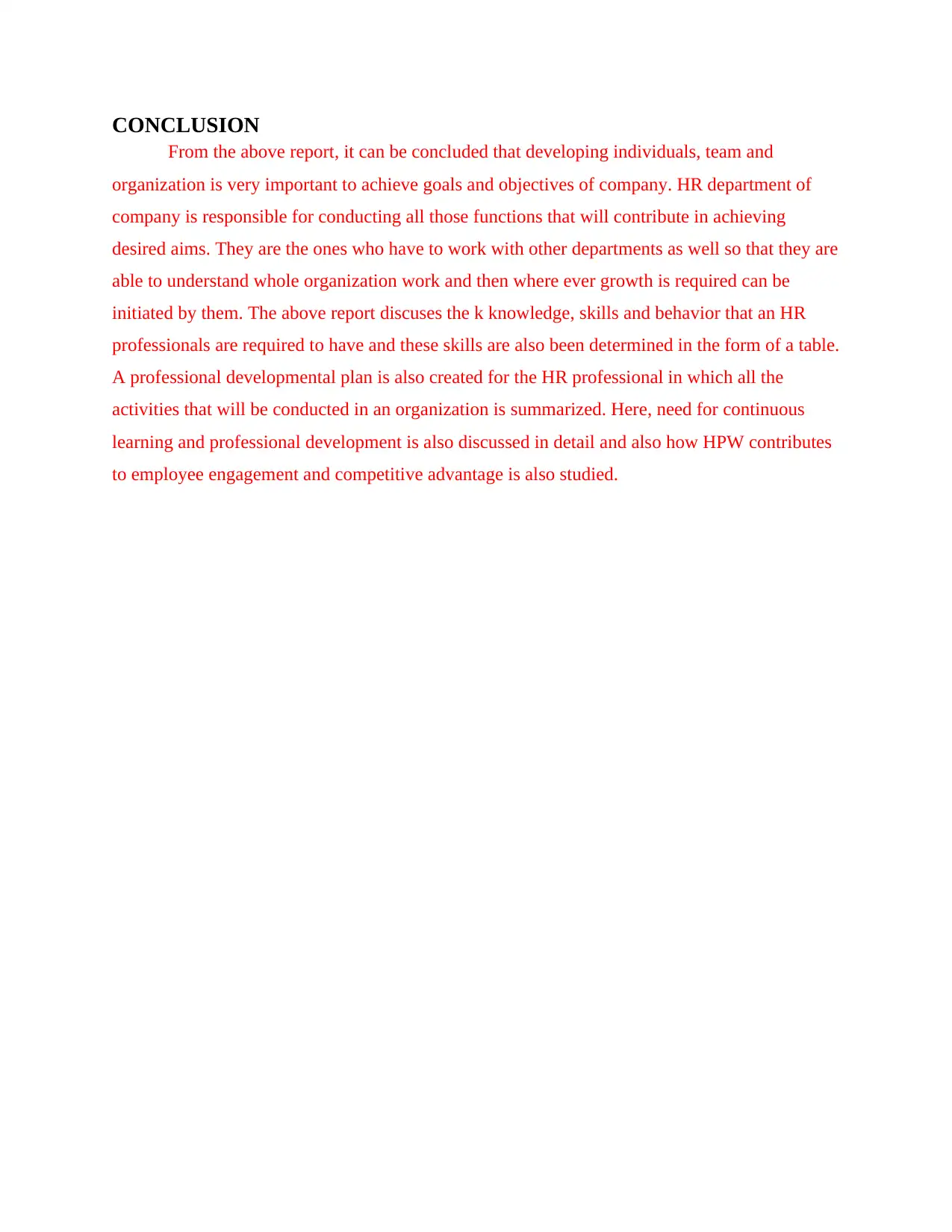
CONCLUSION
From the above report, it can be concluded that developing individuals, team and
organization is very important to achieve goals and objectives of company. HR department of
company is responsible for conducting all those functions that will contribute in achieving
desired aims. They are the ones who have to work with other departments as well so that they are
able to understand whole organization work and then where ever growth is required can be
initiated by them. The above report discuses the k knowledge, skills and behavior that an HR
professionals are required to have and these skills are also been determined in the form of a table.
A professional developmental plan is also created for the HR professional in which all the
activities that will be conducted in an organization is summarized. Here, need for continuous
learning and professional development is also discussed in detail and also how HPW contributes
to employee engagement and competitive advantage is also studied.
From the above report, it can be concluded that developing individuals, team and
organization is very important to achieve goals and objectives of company. HR department of
company is responsible for conducting all those functions that will contribute in achieving
desired aims. They are the ones who have to work with other departments as well so that they are
able to understand whole organization work and then where ever growth is required can be
initiated by them. The above report discuses the k knowledge, skills and behavior that an HR
professionals are required to have and these skills are also been determined in the form of a table.
A professional developmental plan is also created for the HR professional in which all the
activities that will be conducted in an organization is summarized. Here, need for continuous
learning and professional development is also discussed in detail and also how HPW contributes
to employee engagement and competitive advantage is also studied.
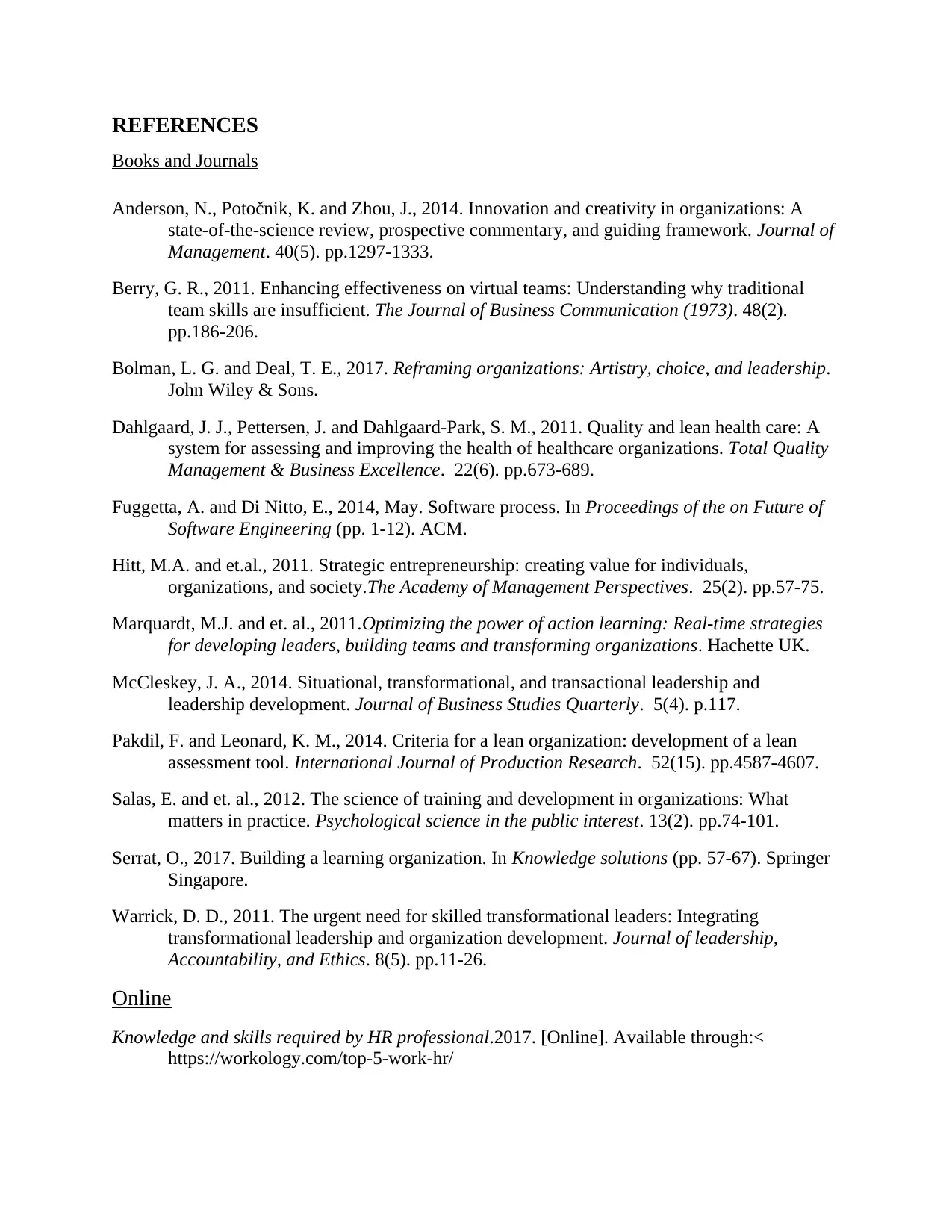
REFERENCES
Books and Journals
Anderson, N., Potočnik, K. and Zhou, J., 2014. Innovation and creativity in organizations: A
state-of-the-science review, prospective commentary, and guiding framework. Journal of
Management. 40(5). pp.1297-1333.
Berry, G. R., 2011. Enhancing effectiveness on virtual teams: Understanding why traditional
team skills are insufficient. The Journal of Business Communication (1973). 48(2).
pp.186-206.
Bolman, L. G. and Deal, T. E., 2017. Reframing organizations: Artistry, choice, and leadership.
John Wiley & Sons.
Dahlgaard, J. J., Pettersen, J. and Dahlgaard-Park, S. M., 2011. Quality and lean health care: A
system for assessing and improving the health of healthcare organizations. Total Quality
Management & Business Excellence. 22(6). pp.673-689.
Fuggetta, A. and Di Nitto, E., 2014, May. Software process. In Proceedings of the on Future of
Software Engineering (pp. 1-12). ACM.
Hitt, M.A. and et.al., 2011. Strategic entrepreneurship: creating value for individuals,
organizations, and society.The Academy of Management Perspectives. 25(2). pp.57-75.
Marquardt, M.J. and et. al., 2011.Optimizing the power of action learning: Real-time strategies
for developing leaders, building teams and transforming organizations. Hachette UK.
McCleskey, J. A., 2014. Situational, transformational, and transactional leadership and
leadership development. Journal of Business Studies Quarterly. 5(4). p.117.
Pakdil, F. and Leonard, K. M., 2014. Criteria for a lean organization: development of a lean
assessment tool. International Journal of Production Research. 52(15). pp.4587-4607.
Salas, E. and et. al., 2012. The science of training and development in organizations: What
matters in practice. Psychological science in the public interest. 13(2). pp.74-101.
Serrat, O., 2017. Building a learning organization. In Knowledge solutions (pp. 57-67). Springer
Singapore.
Warrick, D. D., 2011. The urgent need for skilled transformational leaders: Integrating
transformational leadership and organization development. Journal of leadership,
Accountability, and Ethics. 8(5). pp.11-26.
Online
Knowledge and skills required by HR professional.2017. [Online]. Available through:<
https://workology.com/top-5-work-hr/
Books and Journals
Anderson, N., Potočnik, K. and Zhou, J., 2014. Innovation and creativity in organizations: A
state-of-the-science review, prospective commentary, and guiding framework. Journal of
Management. 40(5). pp.1297-1333.
Berry, G. R., 2011. Enhancing effectiveness on virtual teams: Understanding why traditional
team skills are insufficient. The Journal of Business Communication (1973). 48(2).
pp.186-206.
Bolman, L. G. and Deal, T. E., 2017. Reframing organizations: Artistry, choice, and leadership.
John Wiley & Sons.
Dahlgaard, J. J., Pettersen, J. and Dahlgaard-Park, S. M., 2011. Quality and lean health care: A
system for assessing and improving the health of healthcare organizations. Total Quality
Management & Business Excellence. 22(6). pp.673-689.
Fuggetta, A. and Di Nitto, E., 2014, May. Software process. In Proceedings of the on Future of
Software Engineering (pp. 1-12). ACM.
Hitt, M.A. and et.al., 2011. Strategic entrepreneurship: creating value for individuals,
organizations, and society.The Academy of Management Perspectives. 25(2). pp.57-75.
Marquardt, M.J. and et. al., 2011.Optimizing the power of action learning: Real-time strategies
for developing leaders, building teams and transforming organizations. Hachette UK.
McCleskey, J. A., 2014. Situational, transformational, and transactional leadership and
leadership development. Journal of Business Studies Quarterly. 5(4). p.117.
Pakdil, F. and Leonard, K. M., 2014. Criteria for a lean organization: development of a lean
assessment tool. International Journal of Production Research. 52(15). pp.4587-4607.
Salas, E. and et. al., 2012. The science of training and development in organizations: What
matters in practice. Psychological science in the public interest. 13(2). pp.74-101.
Serrat, O., 2017. Building a learning organization. In Knowledge solutions (pp. 57-67). Springer
Singapore.
Warrick, D. D., 2011. The urgent need for skilled transformational leaders: Integrating
transformational leadership and organization development. Journal of leadership,
Accountability, and Ethics. 8(5). pp.11-26.
Online
Knowledge and skills required by HR professional.2017. [Online]. Available through:<
https://workology.com/top-5-work-hr/
1 out of 16
Related Documents
Your All-in-One AI-Powered Toolkit for Academic Success.
+13062052269
info@desklib.com
Available 24*7 on WhatsApp / Email
![[object Object]](/_next/static/media/star-bottom.7253800d.svg)
Unlock your academic potential
© 2024 | Zucol Services PVT LTD | All rights reserved.





